|
August Article
|
Japanese Beetles
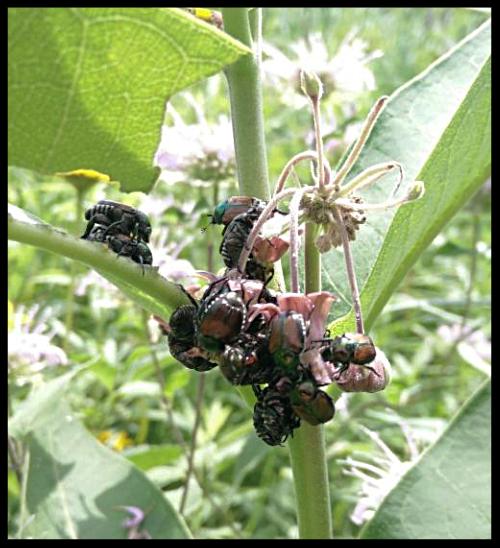
Over the last few weeks, there has been an onslaught of an insect pest that can be intimidating, and even outright frightful to gardeners and restorationists. You may have noticed plants around your home that were savagely defoliated. As you take a closer look, you find hordes of shiny green and copper beetles actively devouring succulent leaves on a variety of plants. These beetles are commonly referred to as "the Japanese beetle" (Popillia japonica), a type of scarab beetle originating from Japan.
This beetle species was first detected in New Jersey in 1916. Entomologists agree that the Japanese beetle entered the U.S. in iris shipments that were not inspected. Due to the lack of natural predators in North America, the beetle has rapidly expanded into the southern U.S, throughout the Midwest and up into Canada. In 2016, the beetle was even detected in Portland, Oregon. The lack of natural enemies and our warmer climate has allowed the North American population to skyrocket.
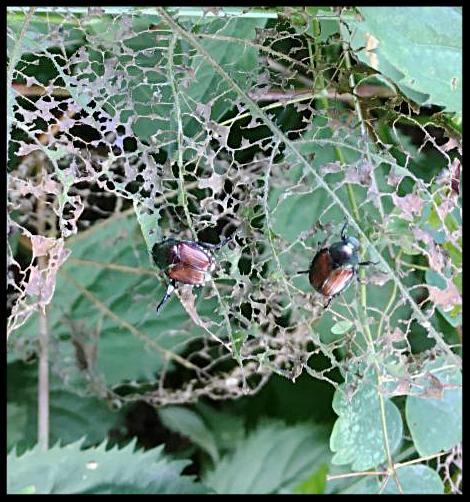
The Japanese beetles are far from picky eaters - they feast on over 200 species. Not only do the adult beetles defoliate plants, the soil-dwelling grubs also destroy plants by consuming root material. The grubs love turf grass roots. Around the Twin Cities, there are certain plant species they seem to target. The USDA has identified plants that this beetle can't resist: grapes, linden, apple, birch, Norway maple, Japanese maple, and rose. Limiting these plant species in your landscape will help reduce the Japanese beetle population around your home. Dogwood, red oak, and ash are some species that have been identified as being least favorable to this beetle.
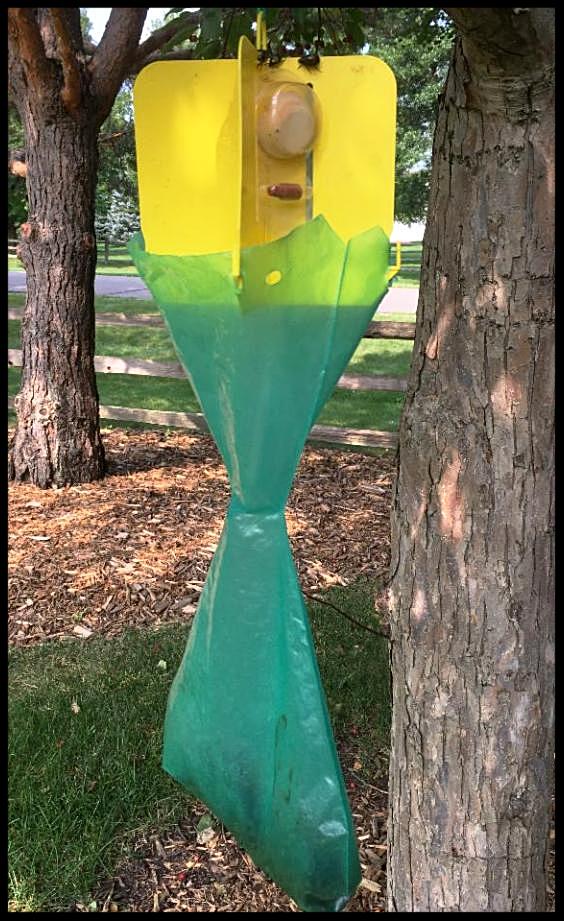
Due to the high economic impact of this non-native invader, many pest control methods have been developed. Probably the most common are beetle traps consisting of a pheromone attractor and floral scent lures the pests into a device that prevents their escape. While it may look like it's working when you have a bag full of beetles at the end of the day, a University of Kentucky study actually concluded that these traps attract more beetles to your garden and cause increased damage to surrounding plants.
Experts are now steering away from the trap approach 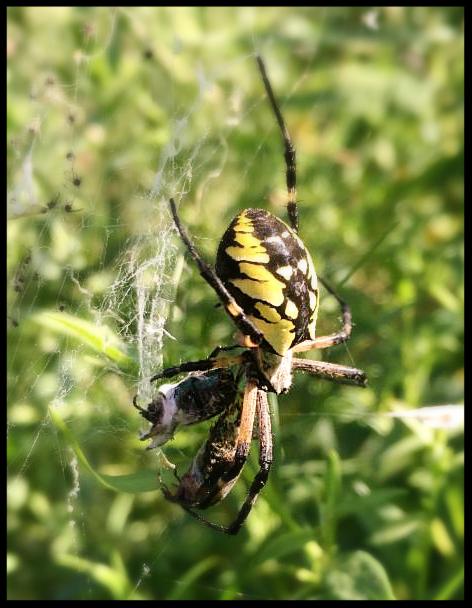 and recommending an integrated pest management strategy. This involves the introduction of vertebrate (grackles, starlings, catbirds, etc.) and invertebrate (spiders, praying mantids, robber flies) predators. In addition, utilizing nematodes and host specific bacterium that kill the beetles when they are still in the larval stage of their life cycle. and recommending an integrated pest management strategy. This involves the introduction of vertebrate (grackles, starlings, catbirds, etc.) and invertebrate (spiders, praying mantids, robber flies) predators. In addition, utilizing nematodes and host specific bacterium that kill the beetles when they are still in the larval stage of their life cycle.
So what does this mean for us? How do we manage our properties to minimize the impact of the Japanese beetle? Here are three simple ideas: 1) Reduce the amount of turf grass lawn. This will minimize the amount of habitat for grubs. 2) Encouraging native plant cover and diversity will also boost ecosystem resilience and health. Natural habitats will attract predators that will consume this invasive beetle. 3) Reduce shrub and tree species that attract the beetle, and replace with species that are less favorable.
Do you need help in getting started? Our amazing staff will help you choose the proper plant species for your restoration. Just give us a call to discuss ways to increase biological diversity and reduce the impact of these pesky beetles!
|
|
Native Plant of the Month
|
Anise Hyssop 
Agastache foeniculum
Moisture: Moist or Dry
Exposure: Full Sun or Partial Shade
Color: Purple
Blooms: July-August
Height: 3-4 Feet
Anise hyssop is a perennial with 4-sided stems typical of Mint Family members. They have dense terminal spikes of blue flowers that are pollinated by honeybees, bumblebees, and other bees seeking pollen.
Their flowers are also attractive to butterflies and hummingbirds for the nectar, and their seeds are often eaten by goldfinches.
The top side of their leaves are dull green with a whitish underside due to short hairs. When you crush the foliage it emits a strong anise smell. More resistant to drought than other Mint Family species, it grows in dry upland woods and prairie. Deer don't like the plant because of its aromatic oils. The flowers are edible and the leaves are used to make tea. Used medicinally for coughs, fevers, and diarrhea. Other common names are blue giant hyssop and licorice mint.
|
|
Invasive Plant of the Month
|
Common Tansy 
(Tanacetum vulgare)
Exposure: Full Sun or Partial Shade
Color: Yellow
Blooms: July-September
Height: 1-5 Feet
A perennial from Eurasia, Common Tansy is a very aggressive plant that spreads by seeds and rhizomes, forming dense stands that choke out native species. They have small yellow flowers that form an umbel on top of long, purplish stems. They have fern-like leaves and deep root systems. Each plant can produce thousands of seeds. Management strategies include timed herbicide treatments and weed whipping flowers to prevent seeds from maturing and spreading.
|
The Wind!
While most of us hardly notice a light summer breeze, the wind is an extremely critical component of ecosystem health. All grasses, sedges, and rushes are wind pollinated. Oaks, alders and some members of the walnut family also rely on wind for pollination. This type of pollination is called anemophily. The flowering parts of an anemophilous plant are optimized to produce light, highly mobile pollen, and large, feathery stigma to readily trap the mobile grains. This type of pollination was developed to increase genetic diversity by separating the male and female reproductive systems. While this system of pollination is extremely important to the health of grasses and other plants- pollen from anemophilous plants causes allergic reactions in many people.
|
|
|
UPDATE:
Our retail nursery is now closed for the 2018 season. Thank you for another wonderful season!
Our retail nursery address is:
1480 County Rd. 90 Independence MN 55359
Click and visit our website for current
|
|
Showy and Dramatic!
These Minnesota native flowers have a little extra flair! These are not your typical daisy-like flower and tend to draw the eye!
1. Rattlesnake Master
(
Eryngium yuccifolium)
2. Prairie Smoke
(
Geum triflorum)
3. Monkeyflower
(
Mimulus ringens)
4. Bottle Gentian
(
Gentiana andrewsii)
5. Prairie Blazing Star
(
Liatris pycnostachya)
Want to learn more about these native plants? Click Here to visit our website!
|
|
Mystery Plant of the Month!
|
|
Test your plant ID skills!
Here is another showy native plant, can you tell what it is? Here are its tiny flowers that do a big job of attracting bees and butterflies!
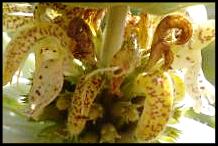
Need another clue?
Take a closer look, these might look like flower petals but they are actually bracts, or modified leaves!
|
|
 |
|